| One of the reasons for going to the Galapagos is to see the giant tortoises which exist no-where else in the world. |
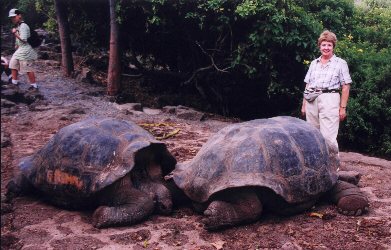 |
| This photo was taken at the Darwin Research station on Santa Cruz. Here Fran stands behind a couple of 500 pound tortoises which are about 150 years old each. Fran is a "spring chicken" by comparison. The story of the tortoise, their development, life, and survival on the islands is unique and interesting so bear with me as I spend some time talking about them. The first thing to keep in mind is that the tortoise is a land reptile while the turtle is a water creature. |
| Only two of the Galapagos Islands have inhabited cities - Puerto Ayora, population 3400, on Santa Cruz and Puerto Baquerizo Moreno, population 3000, on San Cristobal. Santa Cruz Island has a population of about 6000 and is the location of the Darwin Research Center. We arrived at Puerto Ayora late at night after a long day of sailing through a rough sea. Dropping anchor in the calm waters of the protected harbor was a great relief. Surrounding us were many other ships - private and commercial, tall masts and cruise boats. For the first time in several days we were able to see lights of a city on the shore. |
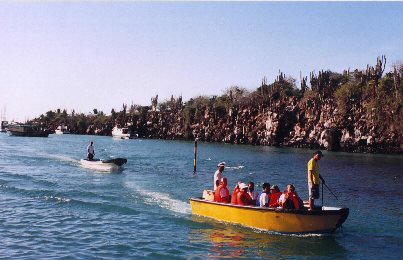 |
| The following morning we were ferried to shore in a water taxi. Here you can see the typical shore line made up of a lava flow to the ocean and limited plant life consisting of cacti growing on the shore. |
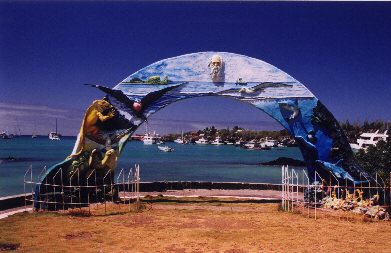 |
The Charles Darwin Arch, which also serves as a gate to the city, is unique: The image of Charles Darwin dominates the scene depicting the birds, fish, animals, and reptiles which are so important to the Galapagos Islands. Puerto Ayora is a small town and the waterfront is crowded with hotels and restaurants. If you are a scuba diver this is where you start your adventure. |
| We were all anxious to see the giant reptiles which inhabit Santa Cruz and we boarded a bus and were driven up the mountain side.
Our first stop was to view several large sink holes which occurred when a volcano collapsed into itself. Every island is unique and those which have high volcanoes may have several different vegetation and climate zones. At the lower levels is the arid zones with its thorny plants with small flowers and cacti. As you go higher you enter the transition zone with small shrubs and different species of cacti. Next comes the high humid zone which is dominated by trees, bromeliads, ferns and orchids. This is the area where coffee, vegetables, oranges and pineapples are grown. In the highest zones at the top of the volcanoes are ferns and grasses. |
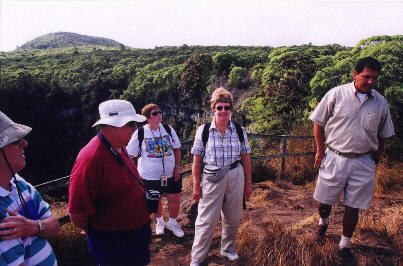 |
| Roberto took us over a rough path through the forest looking for the elusive and very rare Vermillion Fly Catcher. | 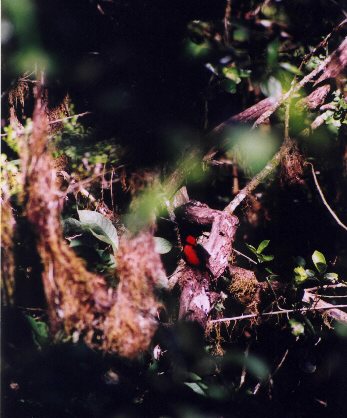 |
This is a tiny bird, not much larger than a sparrow so finding it was a real treat and a testament to Roberto's skills as a naturalist. |
| After we left the volcanic sink holes we again boarded our bus and rode up hill even further. Off the paved road to a gravel road and then a dirt path onto a private farm. Yes, there is still private property on some of the island. The farm lies adjacent to the National Park. Tortoises, like buffalo in Yellowstone National Park, don't understand park boundaries and look for water and food. Unlike the buffalo, however, which are fair game to hunters and ranchers once they cross some magical imaginary boundary of Yellowstone, tortoises are still protected. | 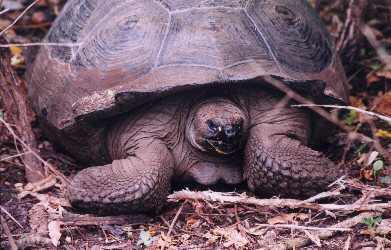 |
| Roberto told us, "The tortoise can go without water for a long time. If there is no rain for a year, they are ok. If there is no rain the second year, that's no problem, but if it doesn't rain for three years they get a little cranky." Living on an island that gets little rain can be taxing to say the least and this ability to survive was part of the reason for their near extinction. During the 18th and 19th centuries whaling ships stopped in the Galapagos for provisions and tortoises were a real treasure. A 500 pound tortoises can live up to three years without food or water in the hold of a wooden whaler. Fresh meat was always available without having to worry about ways to preserve it. Now only 15,000 of these slow-moving giants remain. |
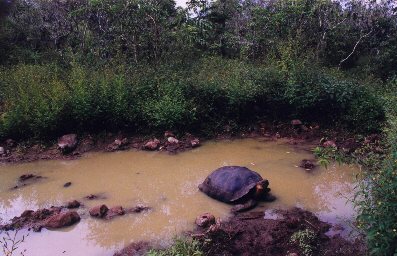 |
| Since water holes are maintained by the farmers for their stock it is only natural that the tortoises also head in that direction. Indeed, as Roberto explained, part of his job as a naturalist with the Darwin Center, is to protect the tortoises. Thus if he sees the farmer doing anything to harm the tortoises, or block their access to the water holes, he reports the farmer and immediate action is taken. In fact, I get the impression that he has authority to break down, or tear down, any fence or other man made structure which may become an obstruction for the Tortoise. But since we had to go on private property to see these land giants in the water hole we happily contributed $2.00 each to the farmer. A small price to pay. |
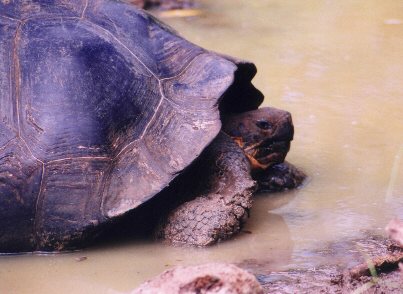 |
Remember that I told you about the goat population? Well, goats abandoned by discouraged by settlers became the next threat to the tortoise. Tortoises would live on the leaves of shrubs and cacti paddles - they would get some water this way as well. The goats also competed for this same food source and since they were much more mobile they could find and eat the food and the slow moving tortoise would starve. As a result, man was able to do what mother nature with all its volcanic eruptions and lava flows and droughts were not able to accomplish. Naturally, today the tortoise is protected by strict conservation laws on the Galapagos. Since the islands are listed on the United Nations wildlife protected areas the navies of the world assist Ecuador in patroling the surrounding seas to prevent poaching of reptiles and marine animals and illegal fishing. |
| There are 14 subspecies of giant tortoise in the Galapagos. They have evolved to be able to survive on the terrain and in the climate of the island where they live. As I have mentioned earlier, the islands are volcanic in origin and thus can have several different climate zones. Remember the Darwin Volcano which we saw at Tagus Cove? | 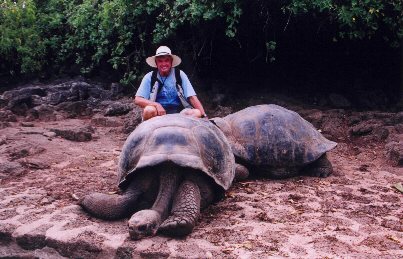 |
At sea level it is a dry lava desert but clouds hover at the top of the volcano and although it doesn't rain the mist provides dew on the plants which in turn provides water to those tortoises which are able to make it to the top during the rainy season. A tortoise with long legs is more agile (relatively speaking!) and equipped to lift themselves over the rough terrain to get to the top. It is a long walk but the reward is life giving. |
| Unfortunately you can't see it in this photo of Darwin Volcano, there are areas where you can see lava flows which have left large isolated patches of vegetation. We were told that the tortoises cannot cross the lava fields surrounding these isolated areas and a subspecies of tortoises have evolved which are able to survive on the limited vegetation and water available. The photographs cannot tell the whole story but it is just fantastic when you are there. Pack up your walking stick and hiking boots and head for the Galapagos. | 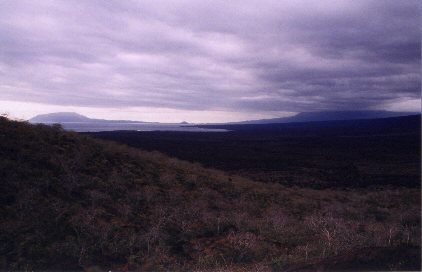 |
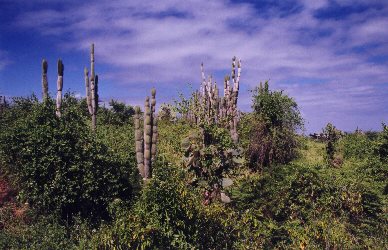 If you are a 300 pound tortoise who lives in "flat land" where it is humid and vegetation is abundant, and grows low to the ground like this at the Darwin Research Center on Santa Cruz, you can have short legs and neck. |
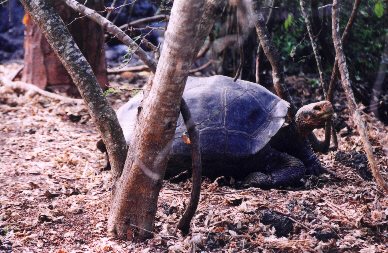 Your shell can look like an army helmet because you doen't have to "stick your neck out" to get food. |
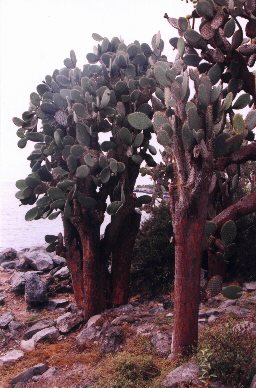 |
But, if you lived where water is scarce and the cacti which you feed on grows tall like trees so the water filled paddles are high off the ground, you develop a shell which has a saddle shape so your long neck can reach higher for the life giving food and water. | 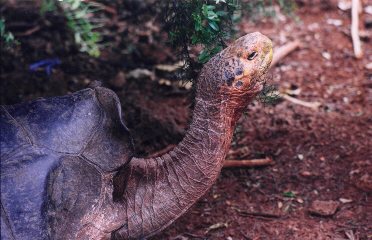 |
| Saving the magnificent Galapagos tortoise has been the major task of the Darwin Research Station on Santa Cruz. On Espanola (Hood) only 10 males and two females of a subspecies were still alive until after years of breeding in captivity some 100 healthy specimens were returned to the island. | 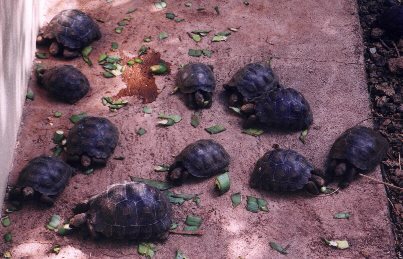 |
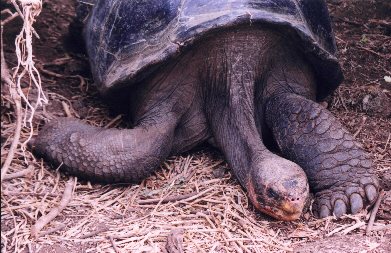 |
...."I'm just a lonesome polecat; I ain't got no lady polecat... " go the lyrics in the song from the movie "Seven Brides
For Seven Brothers". This is a perfect ballad for the most famous tortoise on the Galapagos - "Lonesome George." Lonesome George
is the sole survivor of his specie. Young at 100 years, and at the height of rushing hormones, George remains alone with no lady
tortoise. Attempts to breed him with close, but not perfect, subspecies have proven unsuccessful. A reward of $10,000, which has
been posted for anyone who finds George a mate, goes unclaimed. Now you can understand why poor George is so forlorn.
|
If you have any questions about what you are seeing, or want some further information, feel free to
send me a note. 
If you are looking for a good tour book I recommend Ecuador & Galapagos published by Insight Guides. Although it covers a lot of Ecuador it has the greatest explaination and photographs of the Galapagos Islands. I bought my copy at Barnes and Nobel Bookseller after I returned.

Since October 19, 2002, you are visitor: